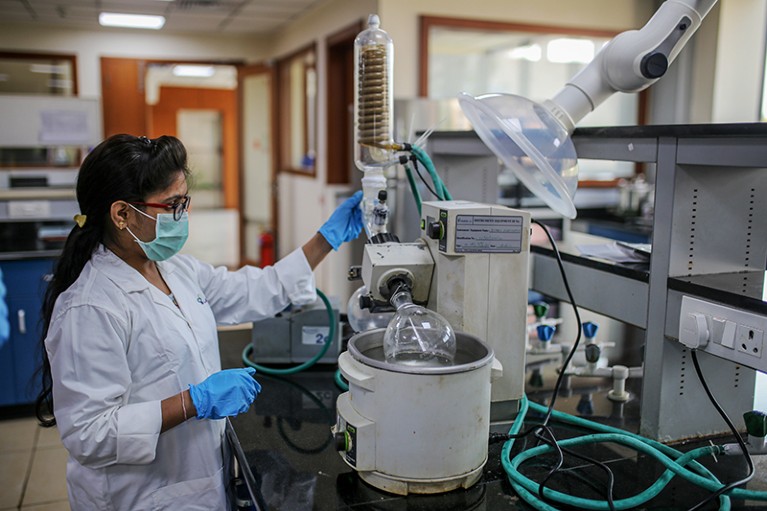
India hopes its new billion-dollar fund will stimulate research.Credit: Dhiraj Singh/Bloomberg via Getty
India is planning to set up a national agency to increase research across the nation’s thousands of universities, colleges, institutes and laboratories. Legislation to establish the fund is expected to be introduced into the Indian Parliament in the next three weeks.
The National Research Foundation (NRF) will have a budget of roughly US$6 billion over five years. Some 70% of these funds is intended to come from investors in the private sector, and the remaining portion will be covered by the government.
The NRF’s goal is to “seed, grow and promote” research across the country’s institutions by strengthening ties between academia, industry and the government, according to a statement from the Ministry of Science and Technology. “It’s a big move,” says Namita Roy Choudhury, a chemical engineer at RMIT University in Melbourne, Australia, who collaborates with researchers at the Indian Institute of Technology Kanpur.
On 28 June, a draft bill to establish the NRF received the go-ahead from India’s senior decision-making body, the Union Cabinet, which is led by Prime Minister Narendra Modi.
If the NRF is approved by parliament, Modi will act as its president, and the science and education ministers will be its vice presidents. The organization will also include a governing board of scientists from various disciplines, and an executive council headed by the government’s principal scientific adviser.
Partha Majumder, a geneticist and the founder of the National Institute of Biomedical Genomics in Kalyani, India, says that he is optimistic about the NRF’s prospects, but that its success will depend on how it is governed in practice. He adds that, as yet, no publicly available documents comprehensively outline how the NRF will operate and achieve its objectives.
Funding boost
Table of Contents
India’s economy is in the world’s top ten by gross domestic product (GDP). However, the nation’s spending on research and development is low compared with that of other countries with large economies, accounting for less than 0.7% of GDP in 2018, the most recent year for which data are available. For comparison, in the same year, China’s research expenditure made up more than 2% of its GDP, and this figure was even higher in the United States (3%). Several countries with smaller economies than India, such as Brazil and Malaysia, spend proportionally more on research and development.
Most of India’s roughly 40,000 higher-education institutions are run by the states, and more than 95% of higher-education students go to state-funded universities and colleges. But these establishments have a limited capacity for research, says policy expert Shailja Vaidya Gupta, a former senior advisor at the Office of the Principal Scientific Adviser to the Government of India. Less than 1% of all higher-education institutions in India conduct research, and state universities receive just 11% of the funds provided by the Department of Science and Technology’s Science and Engineering Research Board (SERB), one of India’s major research funding agencies. Around 65% of the funding from the SERB goes to the Indian Institutes of Technology, which are owned by the federal government.
The NRF was proposed in the 2020 National Education Policy as a way to build research capacity across India’s academic centres, rather than supporting the few that are already carrying out research. The NRF is set to subsume the SERB.
“I think it would be very good to level the playing field,” says Sunil Mukhi, a theoretical physicist at the Indian Institute of Science Education and Research in Pune. “I hope the NRF can do that.”
However, some researchers doubt that the proposed funding body will be able to attract enough investment from the private sector to hit the US$6 billion target. Currently, just 36.8% of India’s investment in research and development comes from industry. By contrast, corporations account for around 80–90% of investment in this area in countries with technology-heavy economies, including Israel, South Korea and Japan. The relatively small contribution of industry to India’s research suggests that attracting corporate investors could be challenging for the NRF, says Mukhi. “We are expecting [the proportion] to double miraculously, but there is no clarity on how this is to happen,” he says.
The minister for science and technology did not respond to Nature’s request for comment.
Still, the funding will be a substantial increase on current levels if the NRF manages to meet its goal of gathering more than $4 billion from industry, says Majumder. “It will be a quantum jump.”
According to a 2019 report from the Prime Minister’s Science, Technology and Innovation Advisory Council, the NRF will be modelled on the US National Science Foundation, which accounts for around one-quarter of federal funding for basic research in the country’s universities and colleges. Although it’s not yet clear how much the NRF will earmark for basic research, Soumitro Banerjee, a physical scientist at the Indian Institute of Science Education and Research Kolkata, and general secretary of the Breakthrough Science Society — a non-profit organization dedicated to promoting scientific ideas — worries that industry investors will gravitate towards projects that have commercial potential rather than those that are driven by curiosity.
A statement released on 3 July by the Breakthrough Science Society said that funnelling grant applications through one centralized funding body, instead of passing them to several smaller agencies that focus on specific areas, would narrow the options available for researchers, particularly those looking to submit proposals that have no “short-term industrial spin-off”.
But Choudhury says that the increased industry investment could create entrepreneurship opportunities for researchers in the early stages of their careers, which could help India retain its scientific talent. It could also help the country to turn more of its research into real-world outcomes, she adds. “The societal impact comes when your research gets translated through industry,” says Choudhury.
